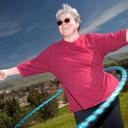Is the Health At Every Size, HAES® approach useful even for people at very high weights?
When someone is immobilized by their weight, it of course has a huge impact on their life. Lynn McAfee is famous for replying to this question, “Just because there is a greater need for weight loss doesn’t make it possible.”
The issue is, what are the odds that pursuing weight loss will make this person weigh less? (tiny) Weigh more? (likely) Feel like a failure? (likely).
HAES® is not against weight loss, but it is against the pursuit of weight loss. This doesn’t mean people might not have legitimate wishes for losing weight, that their lives would be easier or freer from stigma or mobility issues. It’s really about keeping your eye on the ball, which is the practices that are possible in your unique life. If people lose weight doing them, well OK, but you can’t promise it – or imply that if the person just tried hard enough it would happen.
I don’t think there is any data on HAES® in the context of the very heaviest people. But I also don’t think there is data on sustained weight loss for that group of people either.
So what would we offer someone who is similarly mobility-challenged for non-weight-related reasons? Social support, maybe movement opportunities in water, some connection to other super-sized folks who are engaged with life? Adaptations, hope, opportunities to use what you have, like strengthening and flexibility opportunities.
Remember that the strongest people – say, in power lifting, are able to lift (not just move) 600-1000 pounds (say, 270-450kg). It will be undeniably harder for a heavier person to build up the strength to move a heavier body, but it is also true that when you don’t move, you can become bed-ridden at a very low weight. So again, it may be that we just lack the vision of very heavy people being able to move, and fail to see immobilization at higher weights as the same process as at lower weights of becoming less active, losing strength, becoming less active, losing strength, etc. though of course the curve is steeper because it takes more work to move.
It might take a long time but I would guess most people could turn that around with careful, steady, encouraging, and even pleasurable workouts. Imagine if you loved your body, even your very heavy body, and it wasn’t about hating into being smaller. It might feel like a whole different process.
Questions like, “what about people at X weight? Surely you aren’t saying THEY can be healthy,” are all about maintaining that little pocket of the traditional thinking, continuing to have a group to stigmatize, continuing to be able to say that weight is the problem. I just don’t think that is real life. In real life, there is no problem that people of higher weights have that people of lower weights do not, as far as I can see, except the way other people see them.
Deb Burgard, PhD is a psychologist specializing in eating disorders and one of the founders of the Health at Every Size® model. She created the award-winning body image website, www.BodyPositive.com, and blogs for the Association for Size Diversity and Health (ASDAH) at http://healthateverysizeblog.wordpress.com/category/deb-burgard/.




